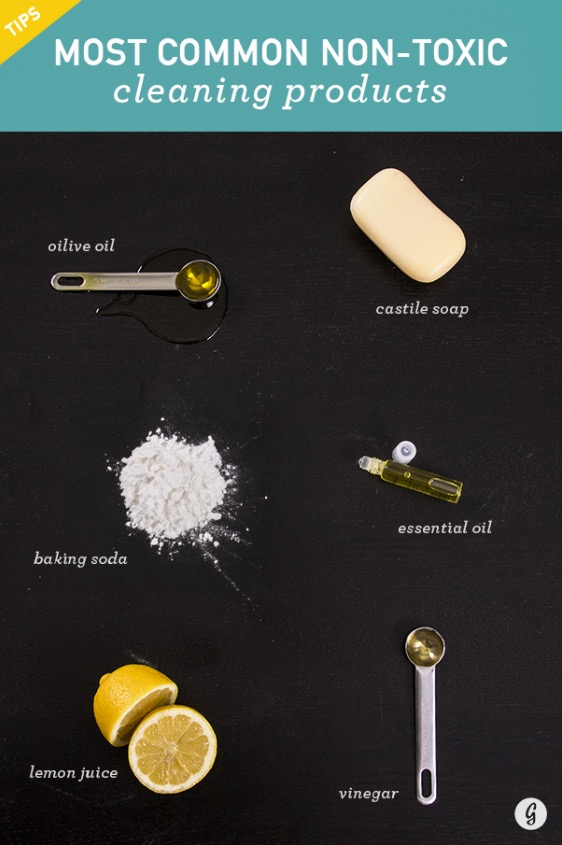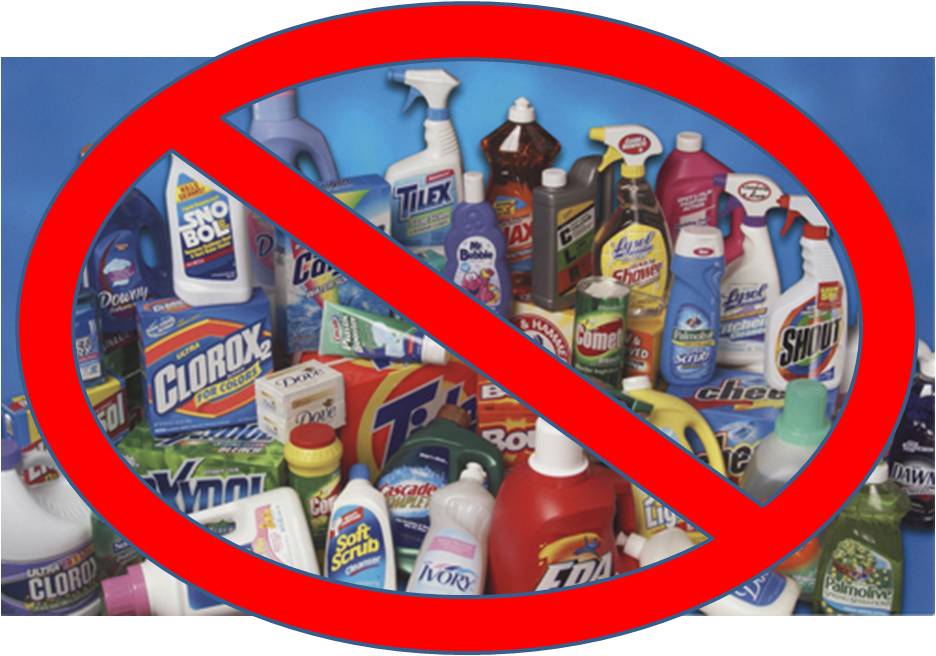Kitchens get dirty quickly, but when you clean them with toxic cleaning products they’re far worse than a little grease and grime. Many all-purpose cleaners, degreasers, oven cleaners and drain clog removers on store shelves contain seriously concerning ingredients for your health and for the environment. The Environmental Working Group (EWG) recently released 10 low-scoring kitchen cleaning products from its database of cleaners. Find out what makes these kitchen cleaning products the worst of the worst.
1. EASY-OFF Professional Heavy Duty Cleaner-Degreaser Concentrate
When you look at a product like this, it makes you wonder: How dirty is your oven, really? Do you actually need industrial grade cleaning power just to remove a bit of stuck on grease? If so, you might want to consider the health risks of using this product. Overall, this cleaner from EASY-OFF earned a big fat F from the EWG. It contains ethoxyethanol, a solvent known to cause respiratory effects if inhaled in high amounts. This chemical also poses concern for endocrine and reproductive effects, meaning it messes with our hormones. While these problems may only occur if exposed to this chemical in high doses, it’s likely not okay to get up close and personal with it while cleaning your oven. Other nasty chemicals in this product include ethylene glycol monomethyl ether and methoxydiglycol. These both pose serious health concerns of their own.
2. Simple Green Concentrated All-Purpose Cleaner
Don’t be fooled by the name. There’s nothing green about this product. Can you say greenwashing? Besides that, it’s hard to know exactly what makes up this all-purpose cleaner because the company had poor ingredient disclosure, according to the EWG. Of the ingredients disclosed by the company, four are still extremely vague: colors, fragrance, mixed alcohol ethoxylate and elemental phosphorus. Known ingredients include 2-butoxyethanol, a confirmed animal carcinogen that poses high concern for digestive system and blood effects in humans; tetrapotassium pyrophosphate, which is highly toxic to the environment; and alcohol ethoxylates (C9-11, 4-8EO), a potential carcinogen. The only ingredients to earn A ratings individually are water and sodium citrate. Overall, this product scored an F from the EWG.
3. Walmart Great Value Heavy Duty Oven Cleaner
This Walmart-brand oven cleaner earned an F overall from the EWG because it’s corrosive and contains ingredients with potential for skin irritation, allergies; damage to vision; and nervous system effects. Its nastiest ingredient, which earned an F individually from the EWG, is morpholine, which can cause severe burns and eye damage. It’s also harmful if inhaled—a great quality in an aerosol cleaner, huh?
4. Lestoil Grease & Stain Heavy Duty Cleaner
While this product may remove grease and stains from your kitchen, it does so with petroleum-derived ingredients, potential carcinogens and other toxic chemicals. Ingredients in the mix include F-rated petroleum distillates, which pose high concern for cancer and damage to DNA; D-rated nonionic and anionic surfactants, non-specific ingredients; and C-rated pinus palustris (longleaf pine) oil, which has potential for skin irritation and allergies. Overall, this cleaner earned an F from the EWG.
5. Drano Professional Strength Kitchen Crystals Clog Remover
If you use this product to unclog a kitchen sink, you’ll also be pouring toxic chemicals down the drain. Of the ingredients disclosed, which isn’t many, the worst ingredients in this F-rated product include aluminum powder and sodium hydroxide. Aluminum powder has potential respiratory and nervous system effects and sodium hydroxide can cause severe burns, eye damage and skin irritation. Yuck.
6. LYSOL Antibacterial Kitchen Cleaner, Citrus
The label on this product only lists less than 99 percent of the ingredients included, according to the EWG. Makes you wonder what you’re spraying on your counter, stovetops and sinks. The EWG lists F-rated quaternary ammonium compounds, benzyl-c8-18-alkyldimethyl, chlorides and alkyl dimethyl benzyl ammonium chlorides (c12-16) as the only known ingredients. The rest of the ingredients are vague terms: degreasers, inert ingredients and detergents. Overall, this product earned an F from the EWG.
7. EASY-OFF Heavy Duty Oven Cleaner Aerosol Spray
This oven cleaner has no place in the kitchen. It’s downright dangerous. The only ingredient listed on the label is sodium hydroxide (lye). And, the cleaner warns that the lye in the product will cause burns to eyes and skin if you come in contact with it. The label also notes to wear long rubber gloves and to use it with adequate ventilation. But, lye isn’t the only harmful ingredient in the mix. Petroleum gases that are potential carcinogens are also in the formula, as well as ethanolamine, which can cause skin burns and eye damage. It’s no surprised that this oven cleaner earned an F from the EWG.
8. Soft Scrub with Bleach Cleanser for Bath and Kitchen, Mountain Breeze
The active ingredient in this general purpose cleaner is sodium hypochlorite, which is extremely toxic to aquatic life. It’s also a potential asthmagen and can cause other respiratory effects. And, the fragrance that makes up that mountain breeze scent? The company doesn’t disclose the ingredients in its fragrance, but you can bet it’s not natural. Overall, this cleanser earned an F from the EWG.
9. Weiman Cook Top Cleaner
Want to know what’s in this cook top cleaner? So does the EWG. No ingredients are listed on the product label. The one determined ingredient is sodium hydroxide, which is highly concerning for skin irritation, allergies and damage. Sodium hydroxide may also cause damage to vision and respiratory effects in high doses. Overall, this product earned an F from the EWG.
10. Bar Keeper’s Friend Soft Cleanser
This toxic product isn’t anyone’s friend. The EWG gave this cleanser an F rating for its poor discloser of ingredients. The only determined ingredient is D-rated oxalic acid, which is harmful if swallowed or it if comes in contact with skin.
This is just a sampling of products in the Environmental Working Group’s Guide to Healthy Cleaning database. Visit the database for more information.
http://www.organicauthority.com/sanctuary/10-worst-kitchen-cleaning-products.html (source)
Solutions
https://greatist.com/health/27-chemical-free-products-diy-spring-cleaning
https://wellnessmama.com/4713/natural-kitchen-cleaning/
8 DIY Kitchen Cleaner Recipes (with Ingredients You Can Pronounce)

These recipes cover the kitchen sink, cutting boards, hardwood floors, and beyond – get ready to scrub up your kitchen with homemade cleaners!
- Lemon & Clove Nightly Sink Scrub – say hello to a super shiny sink with this natural and gentle sink scrubber that works wonderfully to clean and remove surface stains. Via Clean Mama
- Liquid Dish Soap – ever looked at the back of your dish soap at the unpronounceable ingredients? Not only does this liquid dish soap work fantastically, it’s safe and non-toxic. Can’t beat that! Via Mommypotamus
- Wood Butter – bring new life to your wooden cutting boards, bowl, utensils and rolling pins with this nourishing wood butter. Just two ingredients! Via Creative Culinary
- Lemon Scented Glass Cleaner – get rid of those sticky fingerprint and nose prints on oven doors, patio windows and glass surfaces with this lemon powered glass cleaner. Via Ask Anna
- Homemade Cleaner Trio – this set of three homemade cleaners are perfect for gift giving (and keeping!) and scented with a refreshing duo of mandarin orange and lime. Includes labels too! Via Hostess with the Mostess
- Hardwood Floor Cleaner – clean your hardwood floors effectively with this natural and gently scented floor cleaner. Economical and no pickle smell! Via Clean Mama
- Granite Cleaner – clean your granite countertops safely, easily, and thoroughly with this natural granite cleaner. Works like a charm! Via Clean Mama
- Homemade Goo Gone – remove pesky labels and sticky residue on bottles and containers with this goo gone. Not only does it work well, it’s natural and safe! Via Simple is Pretty
Thanks for stopping by!
Subscribe below to get more health hints!
